revisiting the Dark Man – a journey into Queensland's shadow country
- Written by Matthew Condon, Associate Professor, Griffith University
This is an edited extracted of an essay in Griffith Review 65: Crimes and Punishments, edited by Ashley Hay.
One recent Saturday morning, I once again drove my children to the street in Brisbane’s west where I grew up as a boy.
They had been on this journey too many times to remember: the pleasant drive through The Gap in the Taylor Range, past the old jam factory and the golf course, left into Payne Road and then sharp left into the dogleg that is Bernarra Street. Here, in the early 1960s on the frontier of suburban Brisbane, my parents built a small rectangular house on a sloped block.
“We’re seeing the house again?” remarked my daughter, ten. I had lived in this street until I was 12. I had been her age in this strip of red-brick and weatherboard houses, part of an exciting new “estate” where the edge of the city met the bush and boulders of western Brisbane.
On this day, as we cruised into Bernarra Street, we approached the house and noticed, for the first time since my parents had sold it in 1974, that it was for sale again.
There, on the footpath where I had kicked thousands of winning goals for my rugby team, slipped in the wet and lacerated my cheek on the corner of a brick wall, was a real estate sandwich board that declared “Open House”.
Why did I keep returning here, to this stamp of land? I had lived in some of the great capital cities of the world, and yet these few hundred metres of street in Brisbane, a spine of outdated homes, a clutch of footpath jacarandas and poincianas, had become my touchstone.
I had some idea. Everything had started here, in the light of the house upstairs and the shadows of downstairs, with its concrete pillars and exposed timber and raw earth.
Here, the questions were posed. And I only understood, in that moment outside the old house, with my children, bored and rolling their eyes in the back seat of the car, that I had spent my life trying to answer those questions.
“I’m going in,” I told the kids. “I’ll be five minutes. Stay in the car.” “Dad.” “Five minutes, that’s all.”
It’s hard now to remember what I felt walking up and into the house for the first time in almost 45 years because so many emotions were at play. Here, my view of the world was formed. Here, family secrets I didn’t know existed at the time were as solid and deeply buried as the giant boulders of granite on which the house sat. This molten mass had pushed up 200 million years earlier, and then my family came along and constructed a faux-colonial homestead on top.
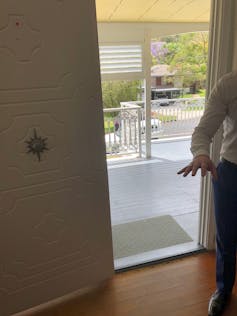 Like pushing back time…
Author provided
Like pushing back time…
Author provided
Going up those stairs and through the front door was, for me, like pushing back time, through decades, thrashing and flailing through the accreted detritus of experience, of life, to the beginning of my existence.
But it was just a house on this hot and glary Saturday, with a real-estate agent in attendance, and some perambulating couples quietly assessing whether this might be where they would settle and raise their own children.
I wandered through the small lounge and dining room, then down the central hall. I peered into what had been my bedroom, an impossibly small space that overlooked the backyard, and had flashbacks so intense I felt dizzy and needed to retreat.
Here, I had met and endured the Dark Man. He was a character that lived in my closet, and sometimes at night he would step into the room. He was tall and wore a long, black coat and a black fedora and he had an infinite, featureless black face. He would stand and stare at me and then disappear into the closet again.
I remembered trying to scream whenever I saw the Dark Man, but no sound issued from my child’s mouth.
I went downstairs again and drifted into the garage area under the house. I had spent countless hours here in the shadows, building a replica of Brisbane in the dirt beneath the floorboards, complete with roads and suburbs and the Brisbane City Hall clocktower, fashioned from a narrow rectangular offcut of wood.
Down in these cool shadows, I could hear my parents and my twin sister shifting about the house above, or the clang of a piece of dropped cutlery, or the flush of the toilet. Sometimes, in the early evening, I could smell from the kitchen the bilious odour of lamb’s fry or boiled chicken or cabbage.
I was always comfortable in this dark space, with my own company. I could play undisturbed for hours, and to be called to dinner was to be to be pulled out of a very real world of my own making. Upstairs, in the light, it comforted me to know that directly below my feet was this block of shadow that belonged to me, and where anything might happen.
On the day of the Open House, I noticed some words written in chalk on one of the house’s wooden supporting beams – “Condon job” – perhaps scrawled there by timber merchants before they loaded it onto a truck and drove it out to the blank concrete slab of our future house in Bernarra Street.
Condon job.
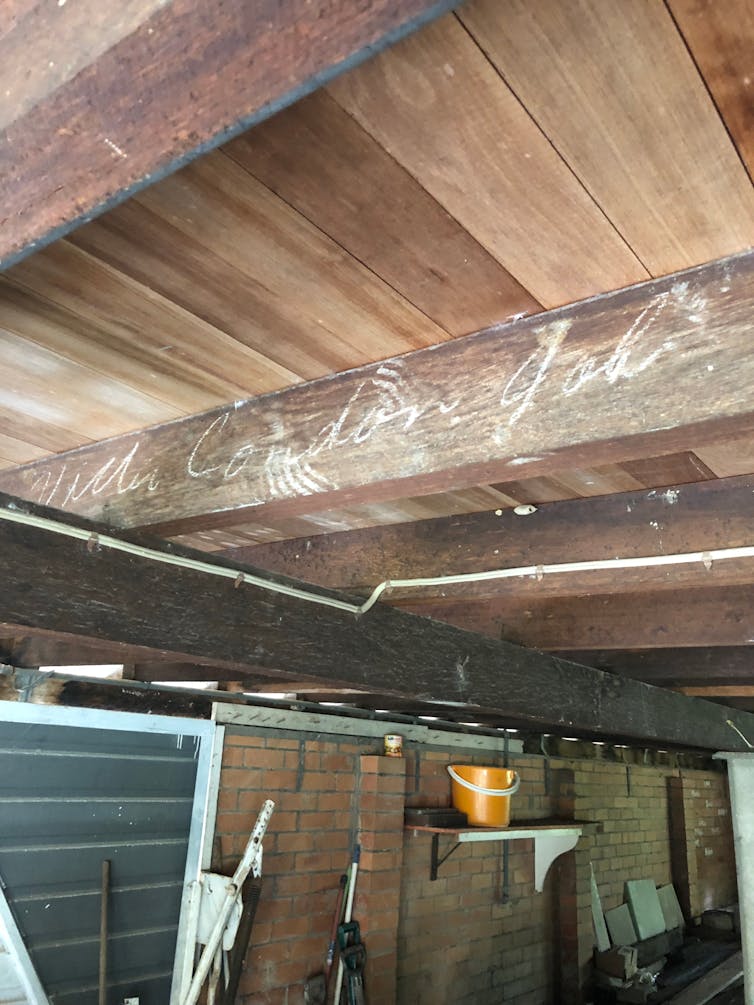 The wooden beam.
Author provided
The wooden beam.
Author provided
That the white cursive had survived for over a half a century was surprising enough. But seeing it now, me twice as old as my father was when we lived in this house, it seemed it could be a message for me that had been sent into the future. Then again, this house had always been my romantic Brigadoon and forever opened that little drawer of hyperbole in me.
I left the cool of the garage and walked down towards my car.
For almost a decade I had worked on the story of Queensland police and political corruption from the 1940s through to the 1990s. I have trawled through Brisbane’s underworld, conducted hundreds of interviews, spent three years of my life interrogating corrupt former Queensland Police Commissioner Terry Lewis, studied thousands of documents, visited the sites of former brothels and illegal gambling joints, had beers with murderers and lattes with old gangsters.
What had begun as a reflex, a seemingly banal decision influenced by curiosity, had swallowed me whole. As the months passed, then years, the exit doors became less frequent, and one phone call led to another email led to another interview led to another discovered document, clue, theory, possibility and conspiracy to the point where it felt as if I had created a map that nobody had ever seen before. It was as though I’d fallen through its co-ordinates and highways and byways and rivers and rivulets and streets and unsealed roads to become trapped on the other side, unable to penetrate a mesh of my own making.
Perhaps this had been the “Condon job” I’d been destined to acquit, the prophecy written in white chalk in the dank undercroft of a featureless suburban house. But as I researched this story over the months, and then years, I was both surprised – and wearily not – that members of my own family had cameos in this narrative, and that I too had been in and around this drama since I was a boy.
Like the house in Bernarra Street, my family history was all light and windows upstairs with a nice view from the veranda, but shadowy and sometimes pitch black down below.
We become writers, I think, because we intuit from a very young age that the picture we see around us is not quite right. That windows stick and doors don’t close smoothly because everything is slightly off balance.
Early on we are riddled with questions that we can’t answer. Then we can’t shake the questions.
We look for that fissure in the wall.
With the story of Queensland crime and corruption, I had accidentally found my fissure.
Then pushed through to the other side.
Behind the cacti
As a child in the 1960s I was free range, exploring my immediate neighbourhood by foot or by bicycle. I knew every square centimetre of my immediate landscape, every tree and ant nest, every gutter and drain. Every car and motorcycle, adult and child.
Around 1968, in Barkala Street, immediately parallel to ours, I was fascinated by one particular vehicle that was often parked out the front of a small house. I found the house curious because its garden was bulging almost exclusively with cacti. The garden beds were like giant fists of swords and daggers, protecting the house’s inhabitants.
It was an ugly and violent and dangerous-looking place.
And then there was the car, an American-style limousine with long, smooth lines that looked as out of place as the garden.
Invariably, waiting beside the car was a man in a uniform and formal cap. I assumed he was the driver of the limousine. I saw the man and the car many times, walked past them and looped my Dragster bicycle in their orbit.
Only decades later, researching the true crime books, did I realise that the man who lived behind the wall of cactus was Queensland Police Commissioner (1958–69) Frank Bischof, father and perfector of the corrupt system known as “The Joke”, a network of graft that would ultimately infect almost every branch of the state’s government, judicial system, public service and community in general for decades. Bischof was vile and self-interested. He was a thug, a bully, a braggart and a world-class liar.
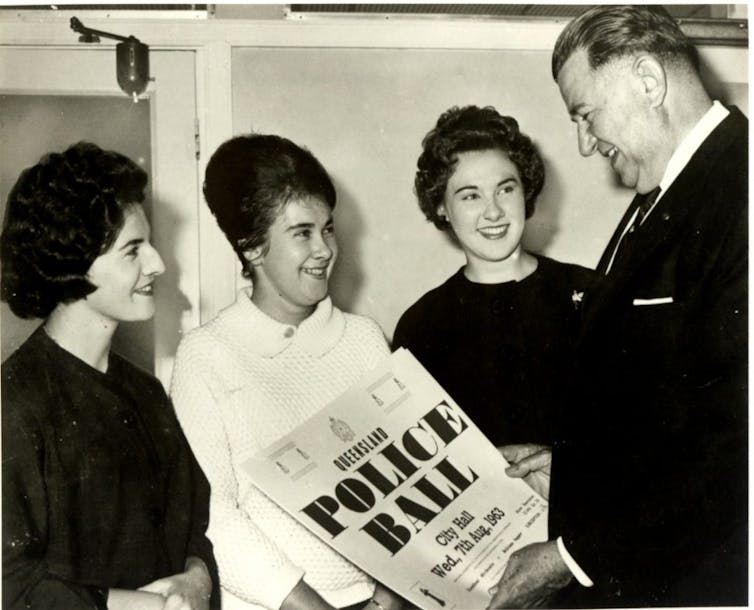 Police Commissioner Frank Bischof discusses the upcoming police ball with three debutantes from the Main Roads Department in 1963.
Wikimedia Commons
Police Commissioner Frank Bischof discusses the upcoming police ball with three debutantes from the Main Roads Department in 1963.
Wikimedia Commons
In the end, the little boy from Bernarra Street, happy-go-lucky on his bicycle, would expose Bischof as a paedophile.
Several of his victims approached me following the publication of the first volume of the Lewis trilogy – Three Crooked Kings (UQP, 2013) – and detailed their abuse at Bischof’s hands; some of those stories were published in the second volume, Jacks and Jokers (UQP, 2014), and in my later books Little Fish Are Sweet (UQP, 2016) and The Night Dragon (UQP, 2019).
Eerie connections
There were other gossamer threads between branches of my family tree and this corruption saga.
In the late 1930s, one particular relation of mine, tall and fit with his hair oiled back, was sent to the Westbrook Farm Home for Boys outside Toowoomba, west of Brisbane. Westbrook was a byword for hell. Here, troubled boys were, in theory, to be shown the path to the straight and narrow. Instead, they were abused, sexually assaulted, in some instances tortured by officials.
Westbrook was a criminal primary school where boys began learning the skills needed for a life of crime. It was where they established friendships that, on the outside, were maintained and morphed into criminal associations. Often, the Westbrook boys would end up together in “high school” – Boggo Road Gaol in Brisbane.
My relative was released from Westbrook when he was 18, in the late 1930s, and immediately embarked on a life of petty crime. He was arrested and incarcerated on multiple occasions. There is little doubt he would have been known to then Detective Frank Bischof, the big wheel down at the Brisbane Criminal Investigation Branch, who used the wartime black market to hone his own skills in extortion and blackmail, used to great effect when he later became police commissioner.
In the late 1940s, my relative was arrested, with another man, on a charge of attempted rape. At around 9pm one evening, he and his friend attacked a young woman and tried to molest her after she’d gotten off a tram.
When he was found guilty and sentenced to seven years’ hard labour, members of my family present in court that day caused such a ruckus – stomping, screaming, crying and shouting obscenities – that the story made national news.
Delving into Brisbane’s underworld, I discovered some eerie connections between this relative and myself.
In the early 1950s, on release from prison, he lived with his parents in the suburb of Red Hill before marrying a young woman, the sister of a friend he made in Boggo Road.
She would die of a mysterious “bowel obstruction” less than a year after their marriage, but not before they lived in a house on Paddington’s Latrobe Terrace in the city’s inner west. That house, I discovered, was less than 400 metres from the house where I raised my own children.
In the 1960s, according to family members, this relative also did “business” in the old Paddington Hotel nearby. That pub, albeit its more respectable modern incarnation, was my local.
Early that same decade, just as my family was settling into Bernarra Street, a young Terence Murray Lewis was raising his own family in Ellena Street in the suburb formerly known as Rosalie but later subsumed by Paddington. (Lewis would be elevated to Commissioner of Police in 1976, and would be jailed for official corruption in the 1990s.)
The Lewis home was two houses up from the local Baptist church. My grandfather George Baker, a motorcycle fanatic, and my grandmother Freda lived one street away from the Lewises in Beck Street. My grandfather helped build that Baptist church. In the little village of Rosalie, with its butcher and barber and picture theatre, there is no doubt the Bakers crossed paths with the young policeman, Lewis, and his family. Both George and Terry were obsessed with motorcycles.
Also in the early 1960s, Bischof promoted Lewis to head of the new Juvenile Aid Bureau. Lewis’s job was to crack down on youth truancy and crime. Curiously, and to the puzzlement of other police, the bureau’s office was established immediately next to the office of the police commissioner.
They called the bureau staff “the bum smackers”, and the job necessitated almost constant contact between Lewis and Brisbane schools, their principals and their errant students.
On a Saturday morning, even Bischof lent a hand. He opened the doors of his office to concerned parents who could bring their naughty children in to be counselled by Uncle Frank. In Jacks and Jokers, I wondered if the “Saturday clinic” was a ruse to give Bischof unfettered access to children: after its publication, many people would tell me this was so.
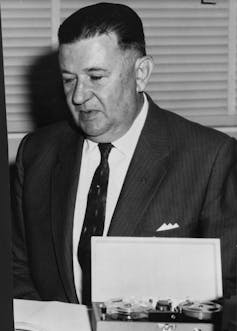 Frank Bischof in 1962.
Frank Bischof in 1962.
Lewis, a compulsive diarist, kept scrupulous notes on his work with the bureau. Dates, times, the names of schools and children, court cases and punishments filled his police diaries.
Decades later, preparing to write the story of Lewis’s life, he allowed me to read his bureau diaries. They were tremendously dull, and yielded little of importance to the story – until I found the names of some of my relatives. These were the children of the attempted rapist. They came to the attention of the bum smackers because they were discovered wandering the streets of Brisbane, wagging school, getting into trouble.
To see their names caught in the net of Lewis’s diary was jolting. Here was another generation of one side of my family emerging in the narrative threads of this story. Here was another point of intersection, where the upstairs floorboards met the shadows under the house.
My relative, he of Westbrook and the sexual assault and the “business” in the Paddo pub – was he the Dark Man in the cupboard at the end of my bed?
I remembered him as impossibly tall, with a handshake that could crush small bones. He was never impolite or aggressive towards me, on the few occasions I saw him. But I did get a glimpse into his family’s world through one of the children he had with his second wife who, when I was about ten, committed a foul and unspeakable act in front of me under the old Queenslander they rented, leaving me shocked and disturbed. Perhaps I was too innocent.
But I have never forgotten that moment, the brief opening and closing of a portal into another world – one most of us are sheltered from, one that speaks to a type of human behaviour guided by no rules or consequences.
I would come across this portal again and again through researching and writing the crime histories, and what I saw and heard I recognised instantly from that brief moment under the Queenslander.
A dream of death
In early 2010, courtesy of an introduction by a friend, I went to visit Terence Murray Lewis, then 82, in Brisbane’s suburban inner north. I had been told Lewis was ready to write his “story”, and that he needed some help. I instinctively knew that if I accepted this project, contingent on Lewis’s approval, it would take up several years of my life. I am now approaching my tenth year.
I have never kept diaries, but in the case of Lewis I decided to take down some notes after our meetings that would, in the end, result in three years of interviews. We met for the first time at 9 am on 1 February 2010. I wrote:
He is sharp and has a cunning air about him. He seems to quickly but expertly self-edit as he speaks. His dialogue is largely emotionless, except when it comes to the miscarriage of justice against him. A couple of times he slips out of character and there is an anger there, a temper beyond the façade, then he pulls it back in. It is the working-class scrapper, self-educated, that peers out from behind the former knight of the realm.
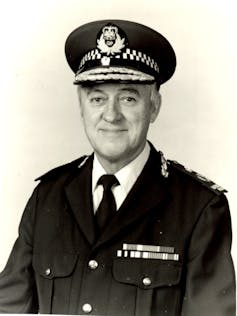 Terence Lewis.
Wikimedia Commons
Terence Lewis.
Wikimedia Commons
The book about Lewis’s life became two books, then a trilogy. It kept going with a fourth volume and a fifth. With the publication of each volume, hundreds of people came forward, volunteering information, personal recollections and documents, exponentially expanding the project, filling in gaps in the mosaic and spawning possibilities for other standalone books. A dozen more are waiting to be written. Whether they will be written by me, I can’t say.
At the time the second volume of the trilogy was published, Lewis severed ties with me and demanded the return of his many papers and documents. The project had not been to his liking, and I had not published the hagiography he had hoped for. I have not heard a single word from him since.
My Lewis diary ends on 11 May 2015, four years and three months after we first met. “I dream of the death of Lewis,” I wrote. (Lewis, 91, lives in Brisbane.)
He’s driving what seems like an old Morris on a highway. He’s wearing a tweed sports coat and a pork pie hat.
I’m both in the car with him when it collides with something. And I’m in a separate car and I see the collision. There is what looks like a sweep ing wave of liquid clay.
Lewis then turns into a black wolf, the wolf disappearing around the corner of a building. When I take a look, I see that he has turned into a black fox. I recover a sheaf of Lewis’ diaries with his familiar handwriting and words highlighted and underlined.
There is a place Lewis has been trying to get to. I get a glimpse of it. A house. Hedges.
A woman. Lewis is now a middle-aged man. He’s wearing a singlet. He’s looking for friends. A green light traces across the sky.
I get a sense he’s truly himself in this place. That it’s the real man at last. There are shadows.
Of course there are shadows. There have always been shadows. I fell into one as a child and I’ve been trying to work my way out of it ever since.
Hideous tales
It is a peculiar place, this shadow country. It can be strangely intoxicating. After a few years in it you begin to learn to find your way around. Over time you become harder to shock. You get to a point where you think you understand this place, only to discover that there’s a darker shadow behind it, and another behind that.
There have been some predictable and some unforeseen personal side effects as a result of working on a project of this magnitude, and one that has involved immersion in stories of murder, child sexual abuse, violence, betrayal and every other regrettable feature of human nature.
I have been told tales that I truly wish I hadn’t heard. Those hideous details can never be unheard.
But one of the worst side effects has been this.
For much of my life after we left that little house in Bernarra Street, I never again woke in the middle of the night to see the Dark Man, with his black fedora and coat and infinite face, at the end of the bed.
I left him behind in that room.
But now, after almost ten years of working in the shadow country, I have not just seen him again. I see him everywhere.
Authors: Matthew Condon, Associate Professor, Griffith University



